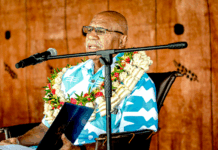
ANALYSIS: By Ella Stewart, RNZ News longform journalist, Te Ao Māori
National Party leader Christopher Luxon made claims about health outcomes that were clearly false. Why was he left unchallenged?
In the TVNZ leaders’ debate last night, Luxon and Labour’s Chris Hipkins had a testy exchange over Māori healthcare.
Hipkins held firm on the creation of a Māori Health Authority, established last year, arguing strongly that the persistent gaps in health outcomes and care justified it.
- READ MORE: NZ election 2023: Hipkins and Luxon in fast-paced debate but fail to excite pundits
- Other NZ election 2023 reports
- Full RNZ data on Māori healthcare
Luxon was equally clear in opposition to it. He framed his critique of the authority around an alleged complete lack of progress on Māori health outcomes. He was very specific.
“Every single health outcome has gone backwards under Chris’s government,” Luxon said.
“Six years, not one has improved for Māori or for non-Māori.”
While sweeping in nature, Luxon’s claim did not get a direct response from Hipkins.
Luxon repeated a similar line later in the debate.
“Gone backwards. Chris, under your government, every single health outcome for Māori or non-Māori [has gone backwards]. You can’t have that.”
Hipkins did push back on this occasion, citing the ongoing reduction in rates of smoking.
Luxon’s claim was far from true — there are a number of areas where health outcomes for Māori and non-Māori have improved while Labour has been in charge.
But it is perhaps understandable that Hipkins was not quick to correct Luxon because the data — even though it’s better in many respects — is still grim. Maybe Hipkins did not wish to dwell on this.
Improved health outcomes
There are a number of health outcomes where, for Māori, statistics have improved.
Perhaps Labour’s biggest boast is their track record on bringing down lung cancer and smoking rates for Māori.
Lung cancer is the second leading cause of death for Māori in Aotearoa. But according to the Ministry of Health, rates of lung disease for Māori have come down.
In 2017, the rate per 100,000 people was 79.9 for Māori. By 2019, it was down to 68.4. This also aligns with smoking rates among Māori dropping.
Pre-colonisation, Māori did not smoke. However, when tobacco was introduced to Aotearoa in the 18th century that quickly changed.
Smoking has been particularly harmful for Māori who have higher smoking rates than non-Māori and experience greater rates of death and tobacco-related illness.
In 2017/18, the smoking rate for Māori adults was 35.3 percent. By 2021/22, it was down to 20.9 percent (approximately 127,000 people).
Rates were falling under National but they have continued to drop under Labour, which has rolled out a number of initiatives in an effort to reduce nation-wide smoking rates.
As part of the Smokefree 2025 Action Plan, historic and world-leading legislation mandated an annually rising smoking age that will mean that anyone born on or after 1 January, 2009, will never be able to purchase tobacco products.
Other cancers
Overall, cancer registrations rates among Māori fell from 416 per 100,000 people in 2017 to 405.7 in 2019.
Breast cancer registration rates for Māori women fell from 140.7 per 100,000 people in 2010 to 122.5 per 100,000 in 2019. Prostate cancer registration rates for Māori fell from 105.5 for Māori in 2017 to 103.5 in 2019.
For non-Māori, overall cancer registration rates increased slightly from 323.2 (2017) to 332.4 (2019).
Life expectancy
The life expectancy gap between Māori and non-Māori may be the most telling indicator of all when it comes to inequities.
According to the latest available data from 2019, life expectancy at birth for Māori men in 2017-2019 was 73.4 years, up 3.1 years from 2005-2007 data.
The life expectancy for non-Māori men is 80.9 years. For Māori women, it was 77.1 years, up 2 years from 2005-2007. Non-Māori women are expected to live to 84.4 years.
While Māori life expectancy has increased over time, the gap to non-Māori persists.
At the current rate of progress it will be more than a century before Māori and non-Māori have equal life expectancy, a study by the Association of Salaried Medical Specialists found in 2021.
Child immunisation
In the debate, after Hipkins raised smoking as an area of improvement, Luxon said child immunisation was a concern. On this, he was correct.
Over the past six years, child immunisation rates have steadily fallen.
In 2017, 86.2 percent of eligible Māori five year olds had completed all of their age-appropriate immunisations. As of last year, the rate had shrunk to only 71.8 percent. That is an alarming 16 point drop in the period Labour has been in power.
In April of this year a report commissioned by Te Whatu Ora’s Immunisation Taskforce found that immunisation failed to achieve “adequate on-time immunisation rates in young tamariki” and to immunise Māori, meaning those who were most susceptible to “vaccine-preventable disease” had the lowest immunisation coverage.
The report highlighted the worst rate in the country — just 34 percent of Māori children in South Auckland were fully vaccinated. It attributed part of the problem to vaccinators being diverted to the country’s covid-19 pandemic response.
“This caused childhood immunisation rates to plummet. These rates are now the lowest they have ever been and ethnic disparities have further expanded,” it said.
The report outlined 54 recommendations covering funding, delivery, technology, communications and governance across the programme.
In the debate, Hipkins suggested the anti-vaccine movement was part of the problem, which he sought to link with National.
National has proposed an immunisation incentive payment scheme. The plan would see GP clinics paid a lump sum for achieving immunisation targets, including full immunisation for two-year-olds, MMR vaccines for ages 1-17, and influenza vaccines for ages 65+.
The clinics would have to either achieve 95 percent coverage for their childhood patients, and 75 percent for the flu shots, or achieve a five percentage point increase for each of those target groups, by 30 June 2024 to receive the payment.
Labour’s Dr Ayesha Verrall said a similar scheme already existed.
Labour has also failed to halt type 2 diabetes, the country’s biggest and fastest growing health condition.
Ministry of Health figures show that in 2021 there were 302,778 people with diabetes, predominantly type 2. Since the Labour government came into power in 2017, the estimated rates of the number of Māori with diabetes per 1000 has risen from 66.4 to 70.1 in 2021.
The rates for non-Māori have also climbed from 27.8 in 2017 to 30.1 in 2021. It is also important to note that the rate of diabetes in Aotearoa has been steadily rising over the past 50 years.
Type 2 diabetes can also lead to devastating health conditions and complications, including heart failure, kidney failure, strokes and limb amputation.
According to Ministry of Health data obtained by RNZ under the Official Information Act, since 2011 there has been a 39 percent increase in diabetic limb amputations across the whole population.
For Māori, the number has more than doubled in the past decade from 130 in 2011 to 211 in 2021. Under Labour, the number of Māori diabetic limb amputations rose by 15 percent.
Māori are still 2.8 times more likely to have renal failure, another complication of diabetes.
Mental health
According to Te Whatu Ora, the rate of suspected suicide per 100,000 Māori population in 2021/22 was 16.1. This is not a statistically significant change from the average of the past 13 years.
This article is republished under a community partnership agreement with RNZ.












































